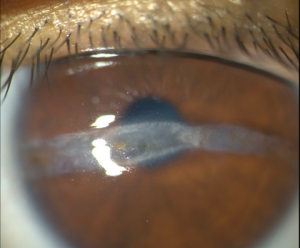Linear Interstitial Keratitis
All content on Eyewiki is protected by copyright law and the Terms of Service. This content may not be reproduced, copied, or put into any artificial intelligence program, including large language and generative AI models, without permission from the Academy.
Disease Entity
Linear Interstitial Keratitis (LIK) is a rare linear stromal lesion of the cornea that has been reported in young adults as early as 1923.[1]
Etiology
Once postulated to be spurred by syphilitic infection, we now know from case reports that anti-treponemal antibodies are generally absent, suggesting positive serology as an incidental finding.[1] The etiology remains unknown, and histology from perforated corneas with LIK undergoing patch grafting has proven unrevealing.[1]
Pathophysiology
Syphilis and Lyme were once implicated in the etiology of this condition, but serologies in patients with LIK have been equivocal without clear positivity across all case reports.[1][2] [3] Petrovic et al suggest that autoimmunity contributes to this condition, but this has not yet been proven.
Diagnosis

Diagnosis is clinical based on the linear appearance of the opacity. Clinical presentation may include blurry vision, tearing, pain, and injection. Other findings may include stromal edema, corneal neovascularization, and and mild iritis. Response to topical steroids supports the diagnosis.
Diagnostic procedures
Diagnosis is clinical based on the linear appearance of the corneal opacity. Cultures may be drawn if an epithelial defect is present, but are not necessary for the diagnosis, and should not demonstrate any growth.
Differential diagnosis
- Interstitial keratitis
- Herpes disciform endotheliitis
- Herpes necrotizing keratitis
- Bacterial keratitis
- Fungal keratitis
- Acanthamoeba
- Neurotrophic keratitis
Management
Medical Therapy
Topical steroids are the mainstay of therapy.
Surgery
Penetrating keratoplasty may be performed for perforation, but surgery is not typically indicated.
Prognosis
The prognosis for recovery with steroid use appears to be good; however, inflammation tends to recur. Counseling patients that this may be a relapsing and remitting disease course is important for expectation management. Long term prognosis may be variable.
Reference
- ↑ Jump up to: 1.0 1.1 1.2 1.3 Calvo, C.M., et al., Linear interstitial keratitis: a distinct clinical entity revisited. Cornea, 2012. 31(12): p. 1500-3.
- ↑ Petrovic, A., et al., Characteristics of Linear Interstitial Keratitis by In Vivo Confocal Microscopy and Anterior Segment Optical Coherence Tomography. Cornea, 2018. 37(6): p. 785-788.
- ↑ Direev, A.O. and V.V. Chernykh, A clinical case of linear stromal (interstitial) keratitis. Acta biomedica scientifica, 2022. 7(4): p. 88-94.
- ↑ Illinois Eye and Ear Infirmary, shared with patient guardian permission
- Rapuano, C., Cornea : Cornea. 2018, Philadelphia, Untied States: Wolters Kluwer.

